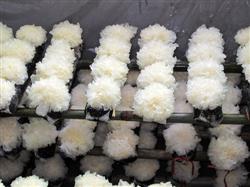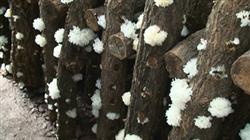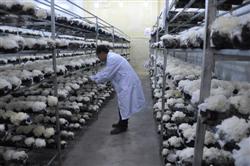How to cultivate and manage Tremella fuciformis?

How to cultivate and manage Tremella fuciformis? Please introduce the cultivation and management of Tremella fuciformis in detail. Please refer to the following methods:
1. The equipment needed to cultivate Tremella fuciformis
The cultivation of Tremella fuciformis is basically based on local materials, so the equipment is relatively simple, including a culture room, a sterilization stove (that is, a soil steaming stove), an inoculation box and small appliances.
(1) Culture room
Is a room of about 12 square meters, general cottages, tile houses, brick walls, earth walls, land, paving can be used, requiring the room wall floor solid and dense, no caves, cracks, so as to avoid the breeding of bacteria and pests. The room is required to be bright and have enough scattered light. Indoor should be easy to keep warm (especially in winter), but also to facilitate ventilation (preferably to form air convection). According to the actual housing conditions, germicidal work is also carried out in the training room, so the culture room had better get a buffer room, which is conducive to shelf, ventilation and other management work.
In the training room, put two rows of shelves against the wall. The legs are 5 to 6 stories high, each 35 cm high. The shelf is 75 cm wide (the inner diameter is not counted as a leg). Tie several bamboo poles or straight sticks on each layer to put the culture medium bag. Shelves are required to be strong, smooth and unloosened.
An agricultural sprayer should be prepared in the training room, which should not be used by those who have been given highly toxic drugs.
(2) Sterilization equipment
The culture medium of Tremella fuciformis is sterilized by atmospheric pressure. That is, it is carried out with a soil steaming stove. Its structure is as follows: a 1.5-meter-high cabinet-shaped steamer is built with bricks on a 1.5-meter x 1.3-meter stove. A feeding door is left on one side, and a small hole for inserting a thermometer is arranged on the top of the door. There is a shelf for feeding in the stove. The shelf should be at a certain distance from the water. The inner wall is polished with cement powder to prevent air leakage. There is a water level observation hole under the feed door and a water feeding port on one side of the rear flue. There is a stove on the flue, set up a small pot, use the waste heat to boil water, add to the stove. So as not to cool down when adding cold water. More than 10 households can use one sterilization stove.
(3) inoculation box
The accessories of the inoculation box are inoculation spoon, inoculum needle and alcohol lamp. Vaccination boxes can also be borrowed from each other.
2. Substitute materials and other materials for cultivating Tremella fuciformis
The substitute materials for the cultivation of Tremella fuciformis are very rich, and the materials used for cultivation are: sawdust and bagasse. The Agricultural Science Research Institute of Dongfeng Comprehensive Reclamation Farm in Fengxin County, Jiangxi Province, also uses straw to produce Tremella fuciformis through two-step treatment.
In order to make use of local resources, we used cottonseed hull, sawdust, corn stalk and cotton stalk to grow Tremella fuciformis successfully. It seems that the production of corn stalk, corncob and cotton stalk must add a variety of elements, and the yield is low, the quality is also poor, want to put into production, we need to do further experiments. The Tremella produced by cottonseed hull and sawdust has good quality and high yield, especially the yield of cottonseed shell is 50% higher than that of sawdust.
(1) Collection of sawdust
When collecting wood chips, in addition to wood such as pine, cypress and camphor, which have germicidal effect, the branches, poles, roots and debris of general broad-leaved trees can be used. Specifically, oak (maple, etc.) companion wood, French sycamore and other wood output is the best. Peaches, pears, apples, poplars and other less, all kinds of mountain trees and plain growth of Chunshu, Robinia pseudoacacia, willow and so on can also be used. The time of collection should be after the fallen leaves and before sprouting, when the wood is the most nutritious. The method of processing is to split and dry the branches, poles and roots of the same kind of tree, and be careful not to get mildew. Then crush it with a general feed grinder. Mildew-proof, moisture-proof, preservation and reserve, each cultivation dosage of about 480 jin. Add other additives can be packed in 5 bags.
(2) cottonseed hull
The cottonseed shell with no mildew, no impurities and less fluff (to facilitate mechanical bagging) should be dried and preserved for cultivation. It takes about 500 jin per planting.
(3) other raw materials
In order to have sufficient minerals and suitable C / N ratio for the growth of Tremella fuciformis, magnesium sulfate, wheat bran, sugar, raw gypsum powder and soybean powder must be added to facilitate the growth of Tremella fuciformis.
(4) auxiliary materials
① plastic bag and its manufacturing method: the plastic bag is in the shape of a long cylinder, which is made of agricultural plastic film (polyethylene) with a length of 50 cm and a width of 27 cm. The bonding method can be made with an electric iron and a "⊥" template. After gluing, fasten one end with thread in advance and dissolve the seal in case of application. It can also be directly contacted with the plastic factory to make a 13 cm wide plastic tube more labor-saving. When filled, the bag is about 40 cm long and 26 cm in perimeter.
② antifungal and germicidal drugs
The performance, use and matters needing attention of several commonly used drugs are introduced below.
A. alcohol: dehydration of bacterial proteins, denaturation and death of bacteria. 75% of alcohol has the strongest germicidal effect.
Usage and usage: commonly used for disinfection of skin utensils and bacteria isolation materials.
Note: this product is flammable and volatile and should be kept sealed. In addition to the high concentration used for lighting, sterilization should be diluted, the effect is good.
B. Cresol (cresol soap solution): 50% cresol soap solution. Its mildew killing ability is 4 times stronger than that of phenol.
Its use and usage is: 1%-2% solution for hand disinfection (soak for 2 minutes). 3% to 4% of the solution is used for indoor spraying and disinfection of utensils. When using, it should be noted that the concentration should not be too high, otherwise the skin will become hard and desquamate.
C. Formaldehyde solution (formalin): 40% formaldehyde aqueous solution. There is a strong stink of irritation. It also has a strong killing effect on bacteria and viruses and irritant damage to the skin tissue of the human body. Its function is to fumigate and disinfect inoculation room, introduction box and culture room. Use 1.52ml per cubic meter of space. The usage is to put the formaldehyde solution into a porcelain bowl to evaporate, or to let it volatilize by mixing two parts of formaldehyde solution with one part of potassium permanganate. The specimen can be preserved in a 10% solution (containing 4% formaldehyde). Pay attention to safety when using formaldehyde solution, because it is very toxic to people and animals and irritates mucous membranes and nerves. D. Bromogeramine solution: is a surface active disinfectant. Its main use is to dilute the original solution from 5% to 25% for skin or utensils disinfection.
E. potassium permanganate (gray oxygen): it is purple needle-like crystal, soluble in water, is a strong oxidant. Disinfect utensils and hands with 1RV 1000 aqueous solution. It should be used whenever it is used, and the solution should not be put for a long time after preparation.
F. Phenol (carbolic acid): it is a white crystal that oxidizes pink in the air and turns crimson with light. It can damage the cell membrane of microorganisms and make proteins denatured and precipitated. Spray and disinfect utensils with a concentration of 3% to 5%. The irritation of phenol is very strong and has corrosive effect on the skin, so we should pay attention to it when using it. G. Mercury: it is a white crystalline powder, soluble in water, highly bactericidal, toxic to organisms, and easily absorbed by skin and mucous membranes. 0.1% solution was used to disinfect the surface of the strain separation material. Liter mercury is highly toxic and long-term exposure should be avoided.
H. Sulfur: is a yellowish crystal or powder, flammable. Smoke release has a strong killing ability to miscellaneous bacteria. Sulfur is mainly used for fumigation inoculation room, culture room. Use 15 grams per cubic meter of space. Spraying indoor water before fumigation can increase germicidal efficacy. Sulfur smoke is harmful to human beings and animals, and attention should be paid to the accumulation of poisoning.
Finally, I would like to introduce bleach. Bleaching powder is a gray-white powder with the odor of chlorine, partially soluble in water, decomposed into iminine in water, infiltrated into bacteria to denature protein, and has a strong and rapid germicidal effect. Scrub the inoculation room, culture room walls, shelf utensils, etc., with 2%-5% aqueous solution. Its germicidal efficacy lasts for a short time and should be used with it.
③ other materials
The cultivation of Tremella also requires a large barrel with adhesive tape. About 2.5 grams at a time. In addition, a small amount of fine cotton thread (for fastening the mouth) and candles (for sealing the bag) are needed.
3. Synthesis and sterilization of culture medium
500 bags is suitable for each cultivation, but it can also be increased or decreased according to the actual situation and cultivation scale.
(1) sawdust medium
Sawdust
480 jin
Wheat bran
144 jin
Soybean powder
9.6 jin
Raw gypsum
9.6 jin
White sugar
9.6 jin
Magnesium sulfate
4.8 jin
water
1:1 to 1:3 of the total
Natural pH of material
- Prev

How to avoid miscellaneous bacteria pollution in the cultivation of Tremella fuciformis?
How to avoid miscellaneous bacteria pollution in the cultivation of Tremella fuciformis? Please introduce the methods of cultivating Tremella fuciformis to avoid miscellaneous bacteria pollution, the key to do a good job in the following aspects: 1, purify the mushroom room environment: often clean up environmental hygiene, and sprinkle lime powder disinfection: strict disinfection and sterilization before cultivation in the room, put an end to pollution sources. 2. Select.
- Next

What are the requirements for moisture, temperature and light in Tremella cultivation?
What are the requirements for moisture, temperature and light in Tremella cultivation? Please introduce the requirements of water, temperature and light for Tremella fuciformis. Water is an important condition for the growth and development of Tremella fuciformis. Tremella needs a lot of water during its growth and development. The fruiting body growth stage needs more water than the mycelium growth stage.
Related
- Fuxing push coffee new agricultural production and marketing class: lack of small-scale processing plants
- Jujube rice field leisure farm deep ploughing Yilan for five years to create a space for organic food and play
- Nongyu Farm-A trial of organic papaya for brave women with advanced technology
- Four points for attention in the prevention and control of diseases and insect pests of edible fungi
- How to add nutrient solution to Edible Fungi
- Is there any good way to control edible fungus mites?
- Open Inoculation Technology of Edible Fungi
- Is there any clever way to use fertilizer for edible fungus in winter?
- What agents are used to kill the pathogens of edible fungi in the mushroom shed?
- Rapid drying of Edible Fungi

